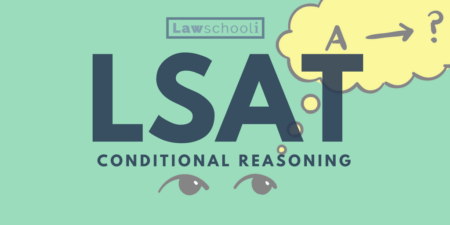This lesson comes from our Mastermind Study Group, which is now underway. Here’s how it works: you self-study (cheap!) but Josh and I guide you every step of the way with live coaching and lessons. Check it out HERE
For our first part of the webinar on “diagramming considerations,” I wanted to take a look at some of the sneakiest, meanest, most insidious rules that you see on the LSAT. In the conditional logic lessons, we’ve gotten pretty used to handling conditional statements. If you spot the word “if” and “then”, I’m pretty confident that you understand that you are dealing with some conditional logic.
Unfortunately, the LSAT doesn’t always give you a bright neon sign with flashing lights saying, “THIS IS IS A CONDITIONAL STATEMENT.” They try to hide it sometimes. While certain logical reasoning questions may be the worst culprit, logic games also hide conditional rules with some regularity. Today, let’s discuss how to spot these hidden rules.
You know how Thomas Jefferson said that “eternal vigilance is the price of liberty”? Well, he may as well have been talking about the LSAT– eternal vigilance is also the price of a good LSAT score. You have to always be aware, be vigilant, and be alert. Let’s start with a bunch of rules similar to what we might get on a logic game. Your task is to decide which are conditional (only apply if certain triggers occur) and which are always in effect.
At an international conference on global warming, 6 keynote speakers are to be selected from among 9 scientists. The 9 scientists include three biologists– H, J, and K, and 3 climatologists– R, S, and T, and 3 hydrologists—U, V and W, and 3 The keynote speakers will speak on the 6 consecutive days of the conference, with exactly one giving their speech each day. The following rules apply without exception:
At least two climatogists must speak.
V will give a speech.
The second climatologist to speak must be followed a hydrologist
Any biologist’s speech must precede a climatologist’s speech.
Here’s a sample order that works, just to help us think about it:
Rc, Sc, Vh, Hb, Tc, Wh
So what’s what here? This is a game with both grouping and ordering elements, often refered to as a combination game. The first rule, “At least two climatologists must speak” is clearly not a conditional rule. It’s a permanent feature of the game. We know all of our climatologists are in. Remember, conditional rules are rules that only apply some of the time. This rule always applies.
The same thing is true of the rule “V will give a speech.” That always applies.
The third rule might be a little harder to sort out…
Does this rule always apply? Yes. It’s a constant feature of the game that we will see in every order. Why? Because of the first rule: At least two climatologists MUST speak, so in each acceptable order, there will be a second climatologist, who is then followed by a hydrologist. You are always going to see a “c h” block.
You could diagram that like this:
c —– c h or c —— c h —– c
In the game, you have a choice of schedule 2 or 3 climatogists, and so you’ll see one of these two orders. Simple right? These diagrammed orders provide and easy visual reference against which you can check any ordering you make when working with the questions.
Now let’s complicate things a bit: if you are being really technical about it, there is a bit of a conditional element to this rule. If you have just two “c”s then you are going to see the order “c —– c h” …whereas if you have three “c”s speaking, you’ll see them in the order c —— c h ——c.
…So you could diagram it like this:
2c —–> c —– c h
3c ——> c —– c h —– c
However, “or” rules are generally mentally easier to work with on games, so when you can write something as an “or” rule, giving yourself just 2 choices to visualize, it’s generally better to do so. The conditional way of writing it might imply to you, incorrectly, that it’s okay to just have one climatologist speak. There are only two possibilities for the game, so just freeze them both in one rule:
c —– c h or c —— c h —– c
Rules that always apply should not be written in a conditional form. It can lead to mistakes and is more mentally cumbersome. Now, this is a pretty advanced concept– it shows us that sometimes the best way to diagram a rule is affected by the other rules and conditions in the game.
I’m going to do a super-advanced quiz right now. What happens if you get rid of the requirement that at least two climatologists speak. Now, the rules look like this:
At an international conference on global warming, 6 keynote speakers are to be selected from among 9 scientists. The 9 scientists include three biologists– H, J, and K, and 3 climatologists– R, S, and T, and 3 hydrologists—U, V and W, and 3 The keynote speakers will speak on the 6 consecutive days of the conference, with exactly one giving their speech each day. The following rules apply without exception:
V will give a speech.
A second climatologist to speak must be followed a hydrologist
Any biologist’s speech must precede a climatologist’s speech.
Are you now better off diagramming the rule like this?
2 “c”s —–> c —– c h
3 “c”s —–> c —– c h —– c
Give your answer/justification in the discussion forum. I’ll throw up a post there where people can answer called “Advanced Mini-Quiz Answers”
Now what about that last rule: “Any biologist’s speech must precede a climatologist’s speech”?
If you are diagramming a million miles an hour, it’s easy to just diagram this like so:
b c
That’s a little block that normally tells us that when you see a “b”, there needs to be a “c” before it, and vice versa. Is that correct here? No. This is a rule that only applies some times. It needs to be diagrammed like the conditional rule that it is. Otherwise, you could get into big trouble in a hurry. The proper way to write the rule is:
b —-> b c
We know that when a biologist speaks, a climatologist must go after him or her. That DOES NOT, however, mean that when a climatologist speaks, a biologist has to go before That would be mistaken inference.
Rules like this are not super common, but they show up a lot when there are more variables than necessary to fill a group or an order, most often when there are more than one of certain subset (the way we have more than one biologist here). You might be able to see that this kind of rule would be silly in a game where there is a one to one ratio of variables to slots where they can go. Take the following scenario:
5 people– D, E, F, G, and H, are going on a waterslide, one after another. All 5 will go down the slide once, and no one goes more than once.
If D goes, the E goes after him.
It’s just silly to write that as a conditional, because D is always going to be in. You are better off just diagramming a block:
DE
Lets move back to our main example. The Trainer gives us a useful way to test for these rules. This is how, you exercise vigilance and catch these when you see them: Think about the rule in both directions. If you put a biologist in the group, it’s pretty easy to see that has to be followed by a climatologist’s speech. What if you put a climatogist in? Does the rule say you now need a biologist too. No. The rule doesn’t apply in “both directions.” It only applies some of the time. That means it’s a conditional rule and you have to diagram it as such.
Okay, that’s it for today’s lesson. Make sure you try to answer the advanced mini-quiz!




4 Comments
Kind of a poorly crafted example, given the ambiguity around “any” (i.e., ‘any and all’ vs. ‘any one of’). Given how its written, you could arguably have:
Biologist 1, Climatologist 1, Climatologist 2, Biologist 2, Hydrologist 1, Hydrologist 2.
But I think what you meant is, “Each time a biologist speaks, a climatologist must follow”…
If you get rid of the requirement that at least two climatologists speak, there could be 0, 1, 2, or 3 climatologists selected.
Here is what I would do, but not sure if it is the most efficient way to do it.
0c —> 3b and 3h
1c
2c —–> c —– c h
3c ——> c —– c h —– c
Is it true that to give my answer/justification in the discussion form, I should be in the Mastermind Study Group?
Next month is my target date to join.
Hi Janet!
Yes, to be in the forum you have to join the Mastermind Group. I’m looking forward to working with you. Email us at mastermind@lawschooli.com if you have any questions about the group.